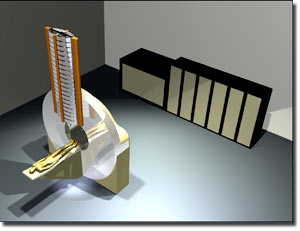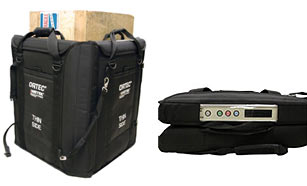Livermore researchers capture two awards for successful projects with U.S. businesses
Lawrence Livermore National Laboratory researchers have been selected to receive two awards for excellence in technology transfer by the Federal Laboratory Consortium.
LLNL’s two awards this year make it one of six research laboratories to garner multiple honors, among the more than 250 federal government laboratories and research centers that comprise the consortium.
Three national laboratories – Los Alamos, Pacific Northwest and Sandia – each won three awards, and two laboratories – the National Renewable Energy Laboratory and the Naval Research Laboratory – besides LLNL won two awards each.
This year’s awards will be presented May 8 during the Federal Laboratory Consortium’s four-day national technology transfer meeting in Portland, Oregon.
Started in 1974, the consortium assists the U.S. public and private sectors in utilizing technologies developed by federal government research laboratories.
Livermore won its two awards for developing the first compact proton therapy system for treating cancer patients and for developing the first portable neutron detector that can assist in interdicting illegal nuclear materials.
Both of the Laboratory’s awards originated from defense-related research that was funded by the National Nuclear Security Administration of the U.S. Department of Energy.
Making proton therapy compact
Undertaken in collaboration with the University of California, Davis Cancer Center, the compact proton therapy system would fit in any major cancer center and cost about one-fifth as much as a full-scale machine.
LLNL licensed the technology in February 2007 to TomoTherapy Incorporated (NASDAQ: TTPY) of Madison, Wis., through an agreement with the Regents of the University of California.
Proton therapy is considered the most advanced form of radiation therapy available, but size and cost have limited the technology’s use to only six centers in the United States and 25 worldwide. Together, they have treated an estimated 40,000 patients.
TomoTherapy will fund development of the first clinical prototype, which will be tested on patients at the UC Davis Cancer Center. If clinical testing is successful, TomoTherapy will bring the machines to market.
Conventional proton therapy facilities use cyclotrons and synchrotrons to deliver protons, and these large facilities can require 90,000 square feet and cost more than $100 million to build.
The Livermore team has overcome the size obstacle by using a dielectric wall accelerator technology that enables proton particles to be accelerated to an energy of at least 200 million electron volts within a lightweight, insulator-based structure about 6.5 feet long.
LLNL’s dielectric wall accelerator advance grew out of work to develop compact, high-current accelerators, such as flash X-ray radiography sources for nuclear weapons stockpile stewardship.
Those receiving awards for the proton therapy work are: LLNL researchers George Caporaso, Stephen Sampayan and Yu-Jiuan Chen; LLNL Industrial Partnerships Office (IPO) employees Genaro Mempin and Roger Werne; LLNL patent attorney James Tak; UC Davis Industry Relations Officer Tod Stoltz; and Associate Director of the UC Davis Cancer Center Dennis Matthews.
Detecting nuclear materials
Several years ago, Livermore researchers developed an advanced neutron source identification system to assist in the interdiction of fissionable materials, which are a critical ingredient for nuclear explosives.
The technology was licensed in 2005 to Oak Ridge, Tenn.-based AMETEK’s Advanced Measurement Technology ORTEC Division – and the result, the next year, was the ORTEC Fission Meter™.
The ORTEC Fission Meter is the first portable neutron detector that can distinguish between a fissile and non-fissile neutron source in real time.
This detector provides "proof positive" identification of fissile neutron sources, such as uranium and plutonium, and it can differentiate between weapons-usable materials and other items.
With its low-cost digital data acquisition unit and high rate of data collection, the Fission Meter can, in real time, process large volumes of data into information that a first responder can use to discriminate materials.
As a result, the detector’s speed and accuracy reduce the need for intrusive inspections, and minimize the impact on commerce.
Recipients of the FLC award for the Fission Meter are: LLNL physicists Mark Rowland, Dan Dietrich, Raymond Alvarez, Neil Snyderman, Manoj Prasad and Phillip Kerr, along with electrical engineer Doug Howard and software engineer Pedro Castro. Other award recipients are Catherine Elizondo of the LLNL Industrial Partnerships Office, Ray Pierce, the Lab’s former Weapons Complex and Integration IPO representative, and Tim Twomey and Daniel Upp, both of AMETEK’s ORTEC Products Group.
Founded in 1952, Lawrence Livermore National Laboratory is a national security laboratory, with a mission to ensure national security and apply science and technology to the important issues of our time. Lawrence Livermore National Laboratory is managed by Lawrence Livermore National Security, LLC for the U.S. Department of Energy's National Nuclear Security Administration.
Contact
Steven Wampler[email protected]
925-423-3107
Related Links
Federal Laboratory ConsortiumTomoTherapy
Ortec
LLNL, UC Davis team up to fight cancer
Proton therapy for prostate cancer: the initial Loma Linda University experience
UC Davis Cancer Center
Loma Linda University Proton Therapy Treatment Center






